“Discover the fascinating world of the Kiwano melon, a flavorful marvel with health advantages and a pleasant African touch.”
Table of Contents
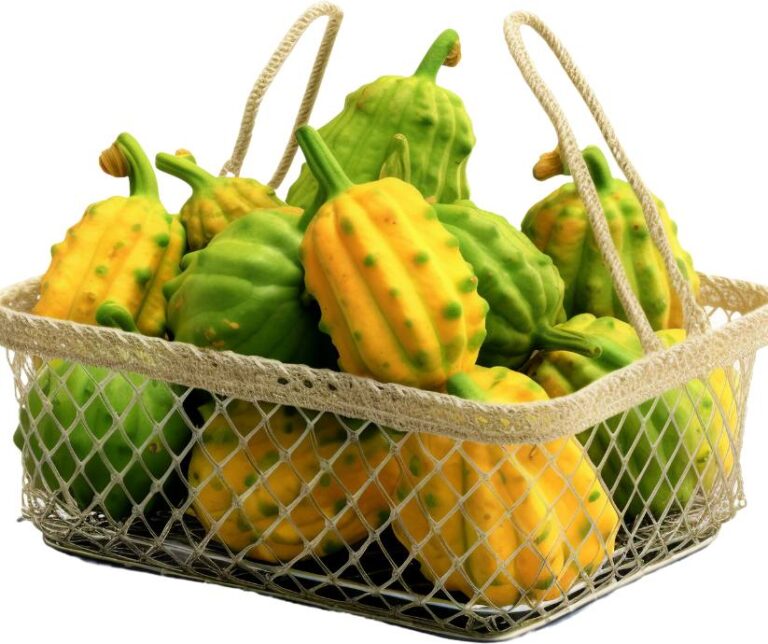
What is Kiwano Melon?
Kiwano melon, scientifically known as Cucumis metuliferus, is a spiky, orange fruit resembling a small oblong watermelon with horns or spikes. It is native to the Kalahari Desert in Africa but is now cultivated in various regions around the world. This unique fruit is not just visually captivating; it offers a plethora of health benefits.
Nutritional Value
Here’s a detailed nutritional chart of Kiwano melon per 100 grams:
Nutrient | Amount |
Calories | 44 |
Carbohydrates | 9.3 grams |
Protein | 1.3 grams |
Dietary Fiber | 3.5 grams |
Fat | 0.9 grams |
Vitamin C | 13.3 mg |
Vitamin A | 44 IU |
Potassium | 309 mg |
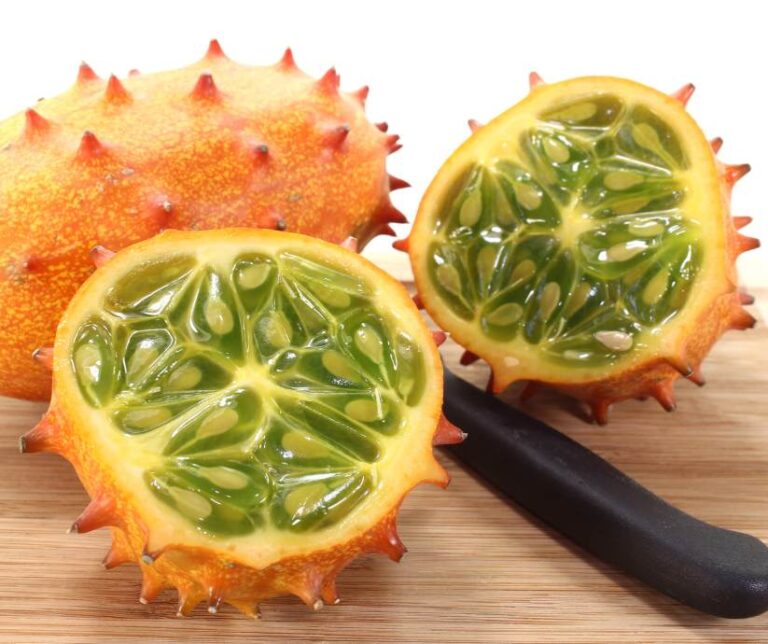
Health Benefits of Kiwano Melon
- Rich in Nutrients: Horned melon is a nutritional powerhouse. It’s packed with vitamins, particularly vitamin C and vitamin A, which are essential for a healthy immune system and good vision.
- Hydration: With its high-water content, Kiwano melon helps keep you hydrated, especially on hot summer days.
- Antioxidant Properties: This fruit is rich in antioxidants like beta-carotene, which helps protect your cells from damage caused by free radicals.
- Weight Management: It is low in calories and contains dietary fiber, making it an excellent choice for those watching their weight.
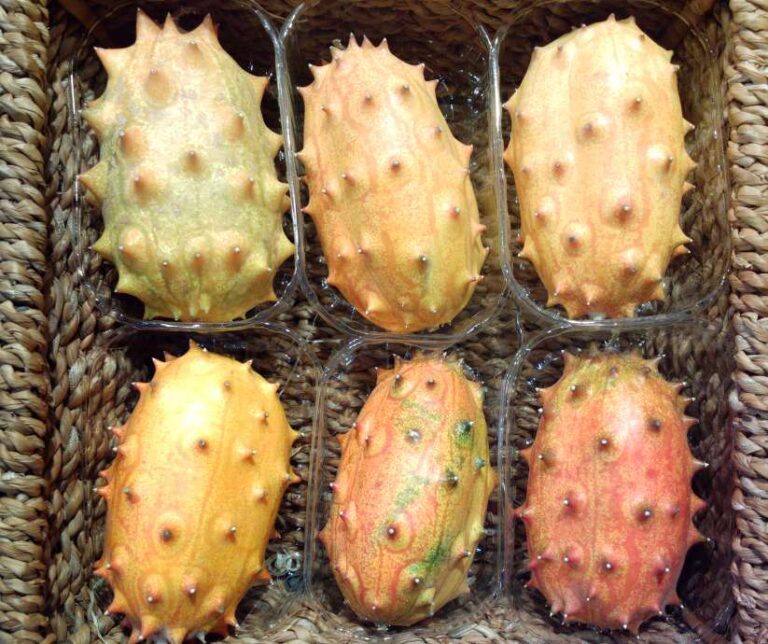
Can We Eat Kiwano Melon?
Yes, you can eat Kiwano melon! Its bright orange, jelly-like flesh is edible and offers a unique taste experience.
How to Eat Kiwano Melon
Eating Kiwano is simple:
- Cut it in half.
- Scoop out the seeds and enjoy the jelly-like flesh.
- Some people add a sprinkle of salt or a squeeze of lime for extra flavor.
Taste Profile
Kiwano has a flavor that’s often described as a combination of banana, cucumber, and lemon. Its mild sweetness with a hint of tartness is truly distinctive.

Culinary Uses
It can be used in various culinary creations:
- Fruit salads for a flavorful and colorful pop.
- Smoothies for a refreshing twist.
- Garnish for desserts, cocktails, or seafood dishes.

Unique Trivia about Kiwano Melon
- Natural Packaging: It has spiky exterior serves not only as a protective feature but also as a natural source of grip when handling this fruit.
- Edible Seeds: Unlike many other melon varieties, Kiwano melon seeds are edible and provide a crunchy texture. They are often used as garnishes and in salads.
- Color Variations: While the most common variety is orange, there are also yellow and red-fleshed Kiwano melons, each with its own subtle flavor variations.
- Horned Melon Olympics: In New Zealand, a quirky sport called “Horned Melon Rugby” involves tossing Kiwano’s as a playful, summer pastime.
“Horned Melon Rugby” is a unique and playful sport that has gained popularity in New Zealand, where participants engage in friendly competition by tossing or rolling Kiwano melons across designated playing areas during the summer months. With its unconventional use of the melon’s distinctive shape and spikes, the sport involves various game variations, from target-based play to obstacle courses, adding an element of unpredictability and amusement to the experience. While not a formalized sport, “Horned Melon Rugby” embodies the joyous spirit of embracing the quirks of the horned melon and serves as a delightful, social pastime that brings people together to celebrate this exotic fruit.

Unique Facts
- It is sometimes called “African Horned Cucumber.”
- It is a member of the Cucurbitaceae family, which includes melon and cucumbers.
- The spiky exterior serves as natural protection for the fruit in the harsh African desert.
- Each fruit typically contains around 150 to 200 small, edible seeds.
Regional Names
Kiwano melon is known by different names in various regions of the world, such as “African Horned Cucumber” in the United States, “Jelly Melon” in New Zealand, “English Tomato” in Australia, and “Kiwano” in Europe.
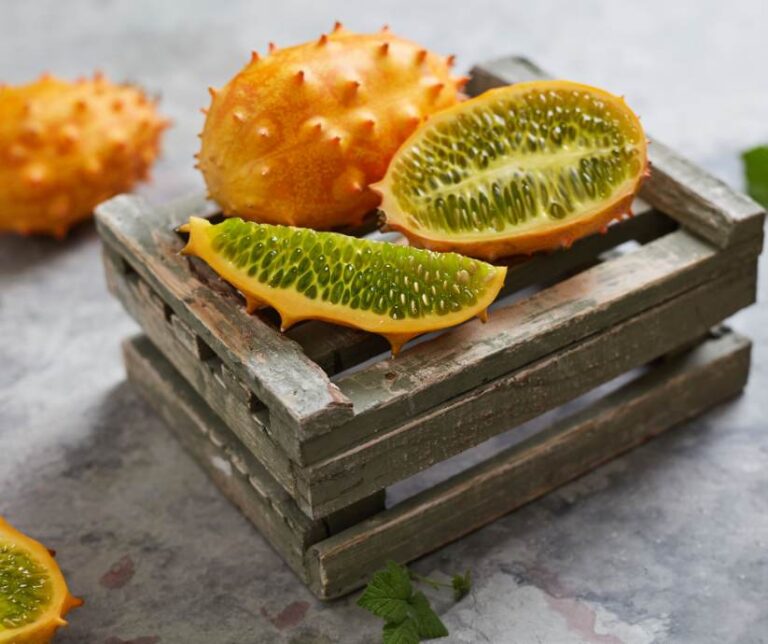
Is It Good for Diabetes?
Kiwano melon can be a suitable addition to a diabetic-friendly diet due to its low glycemic index and fiber content. The low glycemic index means that consuming Kiwano is less likely to cause rapid spikes in blood sugar levels, making it a favorable choice for individuals with diabetes. Additionally, the fruit’s fiber content can aid in stabilizing blood sugar levels by slowing down the absorption of carbohydrates. However, it’s crucial for individuals with diabetes to exercise portion control when enjoying Kiwano, as overconsumption of any fruit can still contribute to an increase in blood sugar levels. Therefore, moderation and regular monitoring of blood glucose levels are key to incorporating Kiwano into a balanced diabetic diet while maintaining optimal glycemic control.

Horned melon exhibits a fascinating range of color variations that add to its allure. While the most commonly encountered variety is orange, it’s important to note that Kiwano melon can also be found in shades of yellow and red. Each of these variations not only contributes to the fruit’s visual appeal but also offers subtle differences in taste and texture.
Orange Kiwano Melon:
- Appearance: The orange Kiwano is the most recognizable variety. It features bright, spiky, and vibrant orange skin that is covered in distinctive horn-like protrusions.
- Flavor: The orange variety typically offers a slightly sweet and mildly tart flavor profile. Its taste is often described as a fusion of banana, cucumber, and lemon, creating a unique and refreshing experience.

Yellow Kiwano Melon:
- Appearance: Yellow Kiwano’s are less common but equally striking. They have a vibrant, sunny yellow exterior with the same characteristic horn-like spikes.
- Flavor: The yellow variety tends to have a milder and sweeter flavor compared to the orange Kiwano. Some enthusiasts even note a hint of tropical fruit in its taste.
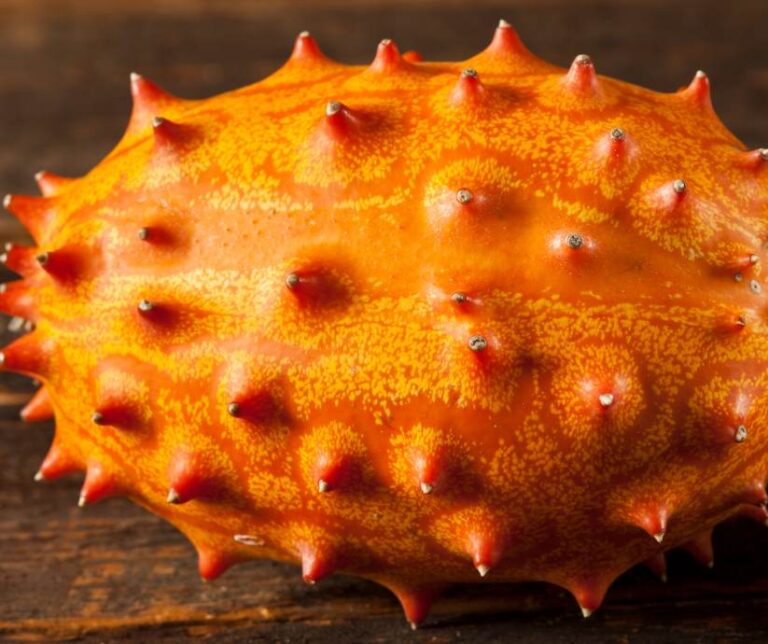
Red Kiwano Melon:
- Appearance: Red Kiwano’s are the rarest of the three color variations. Their skin showcases a stunning red hue with the familiar horned texture.
- Flavor: The red variety is known for its sweet and tangy taste. Some describe it as having a more pronounced sweetness compared to the other colors, making it a delightful treat.
These different color variations of this melon not only offer a visual feast but also provide an opportunity for culinary experimentation. Chefs and home cooks alike can use the distinct colors to add a pop of vibrancy to salads, desserts, and beverages. Whether you choose the bright orange, sunny yellow, or captivating red Kiwano melon, you’re in for a flavorful adventure that goes beyond the typical melon experience.
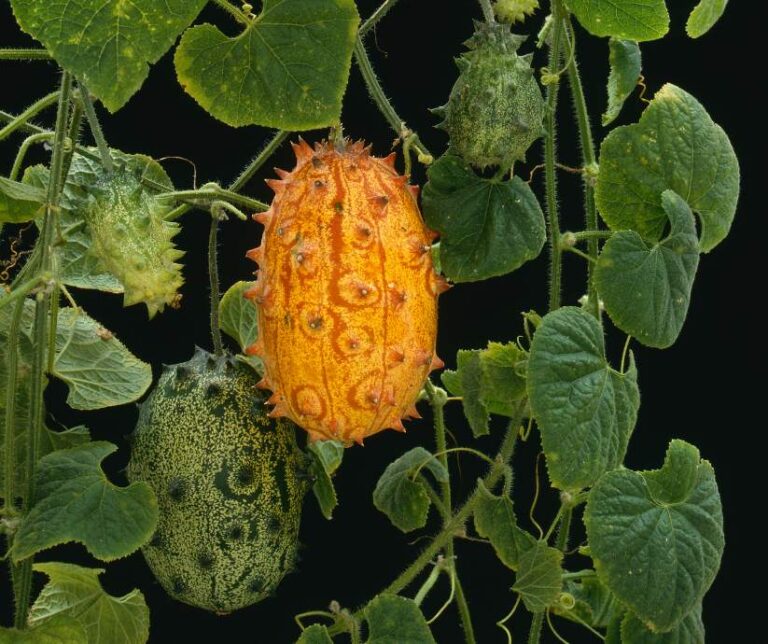
Kiwano Melon Plant
Horned melon plants are unique in their appearance and growth habits. Here’s some more information about this melon plants and their distinctive characteristics:
Kiwano Melon Plant Characteristics:
- Vine Growth: It’s plants are vigorous and sprawling vines that belong to the Cucurbitaceae family, making them relatives of cucumbers and pumpkins. These vines can grow up to 10 to 20 feet (3 to 6 meters) in length.
- Leaves: The leaves of the Kiwano plant are large, deep green, and lobed, similar in appearance to other melon and cucumber plant leaves. They provide the fruit a rich backdrop.
- Flowers: Kiwano plants produce bright yellow, trumpet-shaped flowers with both male and female blossoms. The male flowers typically appear earlier and in greater numbers than the female flowers.
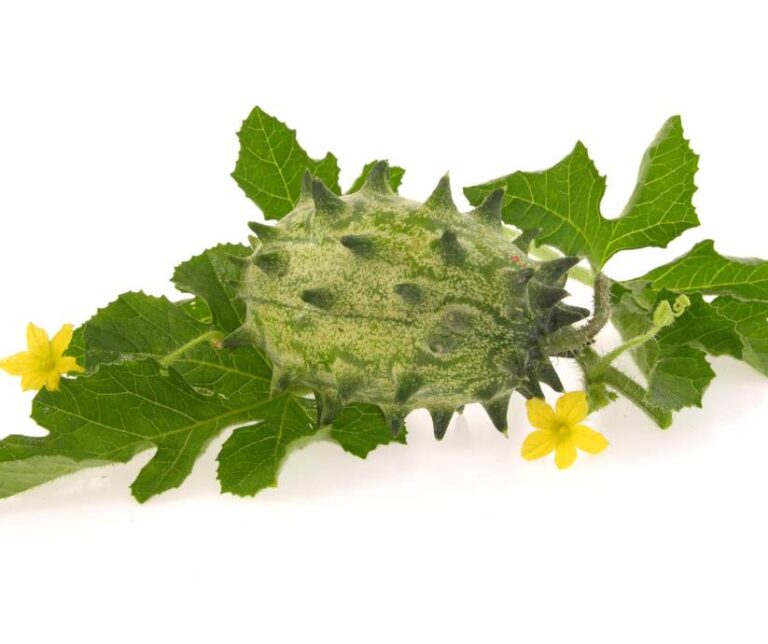
- Fruit Formation: Once pollinated, the female flowers develop into the distinctive melon fruit. The fruit starts out green and gradually changes to its characteristic color as it ripens. The spiky horns or spikes on the fruit’s skin serve as natural protection.
- Climbing Habit: Horned melon vines often require some form of support, such as trellises or fences, to keep the fruit off the ground. This helps prevent damage and rot as the fruit matures.
- Growing Conditions: This melon plants thrive in warm, arid climates. They need a lot of sunlight and soil that drains properly. While they can tolerate some drought, consistent watering during the growing season is essential for healthy fruit production.
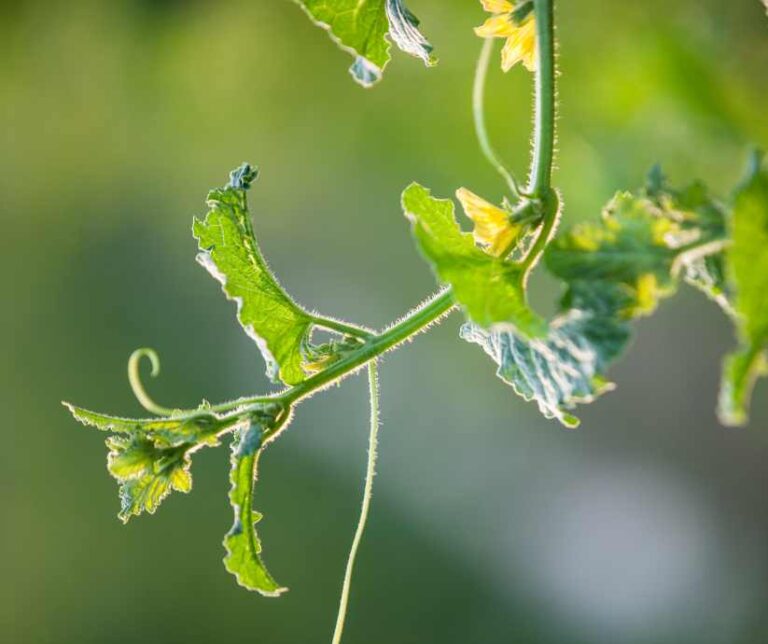
- Pollinators: Like many other melon varieties, Kiwano plants benefit from the presence of pollinators, such as bees, to ensure successful fruit formation. Adequate pollination is crucial for a bountiful harvest.
- Lifecycle: Horned melon plants follow an annual lifecycle, meaning they grow, fruit, and complete their life cycle within a single year. The fruit typically matures and is ready for harvest in late summer or early fall, depending on the growing region.
It’s plants are striking in their appearance, featuring sprawling vines with lobed leaves, bright yellow flowers, and the iconic horned fruit. These vines require support as they grow, and they thrive in warm, sunny climates. Understanding the unique characteristics of Kiwano melon plants can help growers cultivate this exotic fruit successfully.

Cultivation of Kiwano Melon
Kiwano plant thrives in warm, arid climates, making it suitable for cultivation in various regions. Following are some crucial details of its cultivation:
- Climate: Kiwano plant prefers warm temperatures and plenty of sunlight. Tropical and subtropical locations are suitable for its growth.
- Soil: Well-draining sandy or loamy soil is ideal for Kiwano plant. Ensure good soil fertility and pH levels between 6.0 and 7.0.
- Planting: Plant Kiwano seeds directly in the ground or in containers. To allow for healthy growth, place the plants about 3 to 4 feet apart.
- Watering: While Kiwano is drought-resistant, it requires consistent watering, especially during the growing season. Avoid overwatering to prevent root rot.
- Support: Kiwano vines can become quite large and may need support, such as trellises or fences, to keep the fruit off the ground.
- Harvesting: Kiwano are typically ready for harvest when their skin turns orange and starts to soften. You can twist them gently off the vine.

Conclusion
This melon, with its stunning appearance and delightful taste, is a true wonder of nature. It’s not only a feast for the senses but also a healthy addition to your diet. Whether you enjoy it as a snack, in a salad, or as a garnish, this exotic fruit is sure to make your culinary adventures more exciting.
Unlock the flavors of Kiwano melon today and savor the unique essence of this hidden gem from the heart of Africa

Kiwano Melon Magic: 10 Astonishing Health Benefits You Need to Know
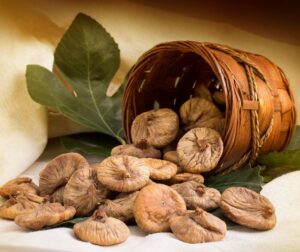
Dried Figs Unleashed 10 Powerful Reasons to Embrace Their Health Benefits, Culinary Magic, and More

Cashew Fruit #1 Nature’s Hidden Gem for Health and Culinary Delights

Red Fruits 17+Deliciously Healthy Additions to Your Diet
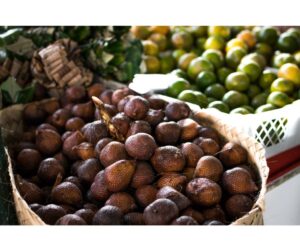
Salak Snake Fruit #1 Nature’s Nutrient-Rich Treasure



1 thought on “Kiwano Melon Magic: 10 Astonishing Health Benefits You Need to Know ”